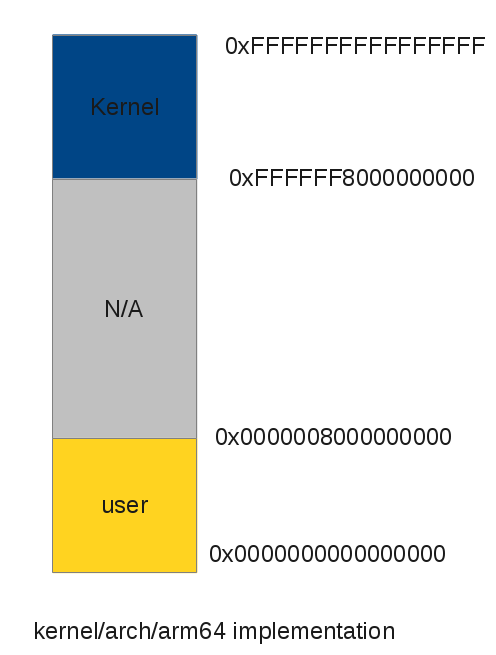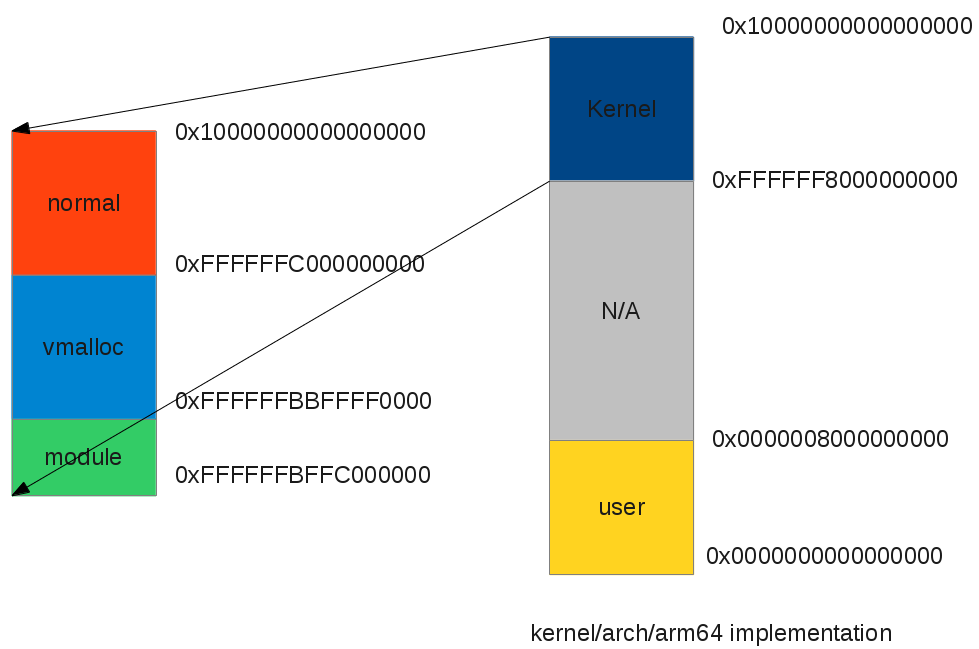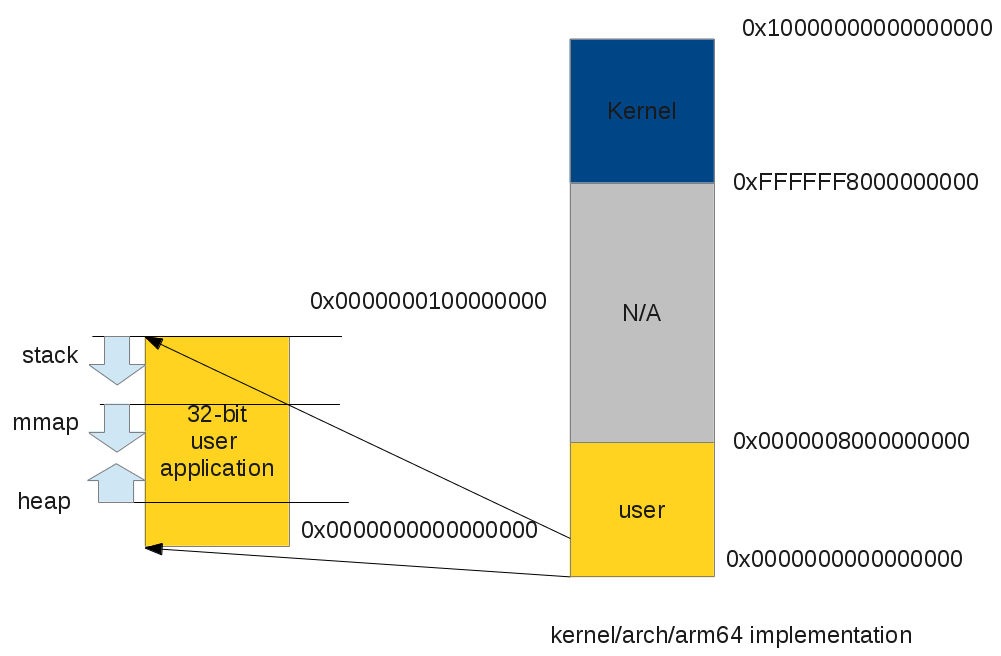ARM64 Linux kernel virtual address space
墙外通道:http://thinkiii.blogspot.com/2014/02/arm64-linux-kernel-virtual-address-space.html
Now let's talk about the Linux kernel virtual address space on 64-bit ARM CPU. You can find information about ARMv8 in ARM official website. http://www.arm.com/products/processors/armv8-architecture.php
Actually 2^64 is too large, so in the Linux kernel implementation, only part of 64 bits are used (42 bits for CONFIG_ARM64_64K_PAGES, 39 bit for 4K page). This article is assuming 4K page is used (VA_BITS = 39 case)
#ifdef CONFIG_ARM64_64K_PAGES
#define VA_BITS (42)
#else
#define VA_BITS (39)
#endif
All user virtual addresses have 25 leading zeros and kernel addresses have 25 leading ones. Address between user space and kernel space are not used and they are used to trap illegal accesses.

ARM64 Linux virtual address space layout
kernel:
Although we have no ARM64 environment now, we can analysis the kernel virtual address space by reading the source code and observing a running AMD64 Linux box.
In arch/arm64/include/asm/memory.h, we can see the some differences: we have no lowmem zone, since the virtual address is so big that we can treat all memory of lowmem and do not have to worry about virtual address. (Yes, there is still a limit of kernel virtual address). Second, the order of different kernel virtual address changes:
#ifdef CONFIG_ARM64_64K_PAGES
#define VA_BITS (42)
#else
#define VA_BITS (39)
#endif
#define PAGE_OFFSET (UL(0xffffffffffffffff) << (VA_BITS - 1))
#define MODULES_END (PAGE_OFFSET)
#define MODULES_VADDR (MODULES_END - SZ_64M)
#define EARLYCON_IOBASE (MODULES_VADDR - SZ_4M)
pr_notice("Virtual kernel memory layout:\n"
" vmalloc : 0x%16lx - 0x%16lx (%6ld MB)\n"
#ifdef CONFIG_SPARSEMEM_VMEMMAP
" vmemmap : 0x%16lx - 0x%16lx (%6ld MB)\n"
#endif
" modules : 0x%16lx - 0x%16lx (%6ld MB)\n"
" memory : 0x%16lx - 0x%16lx (%6ld MB)\n"
" .init : 0x%p" " - 0x%p" " (%6ld kB)\n"
" .text : 0x%p" " - 0x%p" " (%6ld kB)\n"
" .data : 0x%p" " - 0x%p" " (%6ld kB)\n",
MLM(VMALLOC_START, VMALLOC_END),
#ifdef CONFIG_SPARSEMEM_VMEMMAP
MLM((unsigned long)virt_to_page(PAGE_OFFSET),
(unsigned long)virt_to_page(high_memory)),
#endif
MLM(MODULES_VADDR, MODULES_END),
MLM(PAGE_OFFSET, (unsigned long)high_memory),
MLK_ROUNDUP(__init_begin, __init_end),
MLK_ROUNDUP(_text, _etext),
MLK_ROUNDUP(_sdata, _edata));
see also:
arch/arm64/mm/init.c
arch/arm64/include/asm/pgtable.h
You can see that there is no pkmap or fixmap, it's because the kernel is assuming every memory has a valid kernel virtual address and there's no need to create pkmap/fixmap.

ARM64 kernel virtual address space layout
One interesting topic is that ARM claims the ARMv8 is compatible with ARM 32-bit applications, all 32-bit applications can run on ARMv8 without modification.How does the 32-bit application virtual memory layout look like on a 64-bit kernel?
Actually, all process on 64-bit kernel is a 64-bit process. To run ARM 32-bit applications, Linux kernel still create a process from a 64-bit init process, but limit the user address space to 4GB. In this way, we can have both 32-bit and 64-bit application on a 64-bit Linux kernel.
#ifdef CONFIG_COMPAT
#define TASK_SIZE_32 UL(0x100000000)
#define TASK_SIZE (test_thread_flag(TIF_32BIT) ? \
TASK_SIZE_32 : TASK_SIZE_64)
#else
#define TASK_SIZE TASK_SIZE_64
#endif /* CONFIG_COMPAT */
64-bit ARM applications on 64-bit Linux kernel

ARM64 64-bit user space program virtual address space layout
32-bit ARM applications on 64-bit Linux kernel

ARM64 32-bit user space program virtual address space layout
Note that the 32-bit application still have a 512GB kernel virtual address space and do not share it's own 4GB of virtual address space with kernel, the user applications have a complete 4GB of virtual address. On the other hand, 32-bit applications on 32-bit kernel have only 3GB of virtual address space.

ARM64 Linux kernel virtual address space的更多相关文章
- ARM32 Linux kernel virtual address space
http://thinkiii.blogspot.jp/2014/02/arm32-linux-kernel-virtual-address-space.html The 32-bit ARM C ...
- Memory Layout (Virtual address space of a C process)
Memory Layout (Virtual address space of a C process) 分类: C语言基础2012-12-06 23:16 2174人阅读 评论(0) 收藏 举报 f ...
- linux内核可以接受的参数 | Linux kernel启动参数 | 通过grub给内核传递参数
在Linux中,给kernel传递参数以控制其行为总共有三种方法: 1.build kernel之时的各个configuration选项. 2.当kernel启动之时,可以参数在kernel被GRUB ...
- Linux kernel学习-内存管理【转】
转自:https://zohead.com/archives/linux-kernel-learning-memory-management/ 本文同步自(如浏览不正常请点击跳转):https://z ...
- Linux kernel Programming - Allocating Memory
kmalloc #include <linux/slab.h> void *kmalloc(size_t size,int flags); void kfree(void *addr); ...
- Linux kernel学习-内存管理
转自:https://zohead.com/archives/linux-kernel-learning-memory-management/ 本文同步自(如浏览不正常请点击跳转):https://z ...
- Android linux kernel privilege escalation vulnerability and exploit (CVE-2014-4322)
In this blog post we'll go over a Linux kernel privilege escalation vulnerability I discovered which ...
- Linux Kernel - Debug Guide (Linux内核调试指南 )
http://blog.csdn.net/blizmax6/article/details/6747601 linux内核调试指南 一些前言 作者前言 知识从哪里来 为什么撰写本文档 为什么需要汇编级 ...
- Linux kernel memory-faq.txt
## Linux kernel memory-faq.txt What is some existing documentation on Linux memory management? Ulric ...
随机推荐
- 《JAVA程序设计》第四周总结
第四周作业总结 学习内容: 1.根据教材视频学习第五章:子类和继承 2.调试代码和解决问题 3.上周错题 4.代码托管 知识总结 子类:在类的声明中,通过使用关键字extends来定义一个类的子类. ...
- 如何自行搭建一个威胁感知大脑 SIEM?| 硬创公开课
如何自行搭建一个威胁感知大脑 SIEM?| 硬创公开课 本文作者:谢幺 2017-03-10 10:09 专题:硬创公开课 导语:十年安全产品经验的百度安全专家兜哥,手把手教你用开源项目搭建SIEM安 ...
- POJ 1741.Tree 树分治 树形dp 树上点对
Tree Time Limit: 1000MS Memory Limit: 30000K Total Submissions: 24258 Accepted: 8062 Description ...
- Could not transfer artifact org.springframework
无法从中心仓库获取该版本的信息, 从新下载: 1.配置eclipse中的maven user setting路径为本地maven安装路径 配置阿里云镜像路径 <mirror> <i ...
- php正则提取html图片(img)src地址与任意属性的方法
<?php /*PHP正则提取图片img标记中的任意属性*/ $str = '<center><img src="/uploads/images/2017020716 ...
- 深入理解JVM(六)类文件结构
6.1 关于类文件 1.class文件的一次编译,到处运行的跨平台性: 2.JVM不止有跨平台性,还有跨语言性,不管是JRuby还是Groovy写出来的程序,只要编译出符合JVM规范的class文件就 ...
- redis 集群模式安装
概念 Redis集群提供一种方式自动将数据分布在多个Redis节点上. 每个Redis集群中的节点都需要打开两个TCP连接.一个连接用于正常的给Client提供服务,比如6379,还有一个额外的端口( ...
- NAT 模式下虚拟机安装的centos7 ping主机显示connect: Network is unreachable
在虚拟机下安装的centos7使用的网络是NAT模式,安装成功后ping主机地址显示 Network is unreachable 解决方案: 1)使用ifconfig命令查看网卡信息 2)进入/et ...
- python伪装浏览器
def get_content(url): req_header = {'User-Agent':'Mozilla/5.0 (Windows NT 6.1; WOW64) AppleWebKit/53 ...
- java 项目的路径详情
title: 项目下的路径问题tags:grammar_cjkRuby: true--- 在javaee的项目中,存取文件,解析xml和properties文件,以及项目中的文件,都需要获取路径,常用 ...
